Physical Address
304 North Cardinal St.
Dorchester Center, MA 02124
The complexity of the central nervous system (CNS) as well as the bones and soft tissues that provide its protection present special challenges when treating the injured athlete. A thorough understanding of the normal anatomy and biomechanics of the brain and spine are necessary in order to identify pathologic states or unstable injuries and treat them appropriately. The following chapter presents a review of the anatomy of the head and spine, as well as the biomechanics of both normal and injured states. Despite the complexity of this topic, it is possible to identify common patterns that allow an improved understanding of head and spine anatomy that serves as a solid foundation for diagnosing and treating these injuries in the athlete.
The relationships between the rigid bony structures that surround and protect the brain (skull), the spinal cord, and the nerve roots (cervical, thoracic, lumbar, and sacral-coccygeal vertebrae) as well as the intervening soft tissues that provide dynamic stability are outlined below. Athletic injuries can damage these structures by either sudden, high-energy trauma, such as a direct blow or whiplash type injury, to repeated loading within a more physiologic range that nevertheless can cause pain or disability. Spine and brain injuries are greatly feared by athletes in a variety of sports due to their potential catastrophic nature, such as traumatic brain injury (TBI) and spinal cord injury (SCI), which can have life-altering and often irreversible consequences. The following overview of the relevant anatomy is meant to provide a background for understanding the biomechanics of the head and spine as well as the pathologic states that can lead to these potentially devastating injuries.
To best understand how concussions and other brain injuries occur, it is important to fully understand and appreciate the anatomy involved. The anatomy covered within this chapter is a brief overview, which begins with the most external parts and then works through internally. The cranium is the skeleton of the head, a union of functional components combined to form a single skeletal formation. The basic functional component is to house and protect the brain. The skull consists of 22 bones; 8 of which protect the brain—4 singular bones centered along the midline (frontal, ethmoidal, sphenoidal, and occipital) and 2 sets of bones occurring as bilateral pairs (temporal and parietal), with the remaining 14 bones comprising an individual's facial structure ( Fig. 122.1A ). They are essentially fixed, immovable joints, which are connected along multiple suture lines. The only independent movement of the skull occurs at the temporomandibular joint.
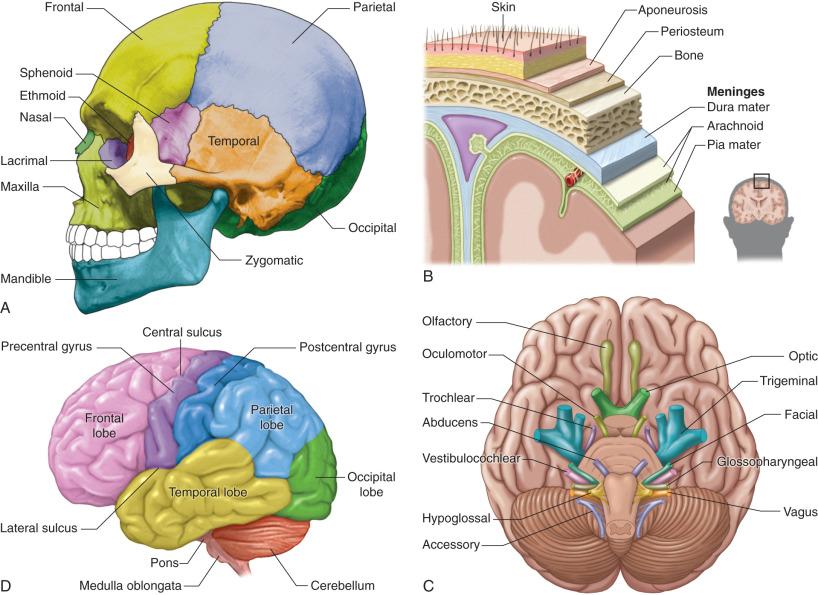
The cranial meninges are the covering of the brain that lies immediately within the skull (see Fig. 122.1B ). Their function is to protect the brain, provide the blood supply, and provide a space for the flow of cerebral spinal fluid . The meninges are composed of three distinct layers: the dura mater, the arachnoid mater, and the pia mater . Each layer has a specific role in the protection of the CNS. The dura mater is the outer-most layer of the meninges and is a tough, thick, bilaminar membrane that adheres to the internal surface of the skull. It is additionally comprised of three layers, which include the periosteal, meningeal, and dural sinus. The periosteal layer lines the skull and the meningeal layer lines the periosteal layer, except when separated by the dural sinus. The dural sinus forms the major venous drainage pathways from the brain, predominantly to the internal jugular veins. The dura mater has an extensive framework of blood supply to itself and provides significant blood supply to the skull through multiple branches of different arteries. The dura mater is also pain sensitive due to being innervated by branches of the trigeminal nerve.
The arachnoid mater is avascular and not attached to the dura mater, but is held in place by the cerebrospinal fluid (CSF). The arachnoid mater is directly above the subarachnoid space, which is a cobweb-like structure housing CSF. The pia mater is the inner most layer of the meninges. It is a highly vascularized structure directly under the subarachnoid space and adheres to the brain by following its contours.
The brain is composed of the cerebrum, cerebellum, and brainstem (see Fig. 122.1D ). When the skull and the dura are removed, the gyri, sulci, and fissures are made visible through the arachnoid and pia layers. The cerebrum is what makes up the major portion of the brain and is divided into two major parts: the right and left cerebral hemispheres, which are separated by the great longitudinal fissure. The two hemispheres can then be subdivided into the frontal, parietal, temporal, and occipital lobes. Each lobe of the brain roughly correlates with the same location as the skull bone by the same name. The two hemispheres of the brain are conjoined by the corpus callosum, which allows the two hemispheres to continually deliver messages to the other. The cerebellum lies posterior to the pons and medulla oblongata. The cerebellum receives afferent information concerning voluntary movement from the cerebral cortex and from the muscles, tendons, and joints. The brainstem consists of the medulla oblongata, pons, and midbrain. This area is crucial for cranial nerve (CN) function, excluding those associated with olfaction and vision, as well as sympathetic and parasympathetic autonomic functions. The brainstem also serves as the location for efferent and afferent pathways to cross between the cerebrum and cerebellum.
The CN are motor or sensory fibers that innervate muscles or glands. An injury can occur to the CN through injury to the skull, excessive movement of the brain, or tumors. There are 12 CN pairs that originate from the brain and penetrate through the dura. They are responsible for a variety of functions and are vulnerable to injury; a detailed review is out of the scope of this chapter (see Fig. 122.1C ).
Head injuries are any injury to the scalp, the skull, or the brain and can range from minor bruising to severe TBI. Head injuries can be classified as closed, in which case the skull remains intact, or open where there is a breakdown of the scalp and/or fracture of the skull. Common head injuries include scalp wounds, skull fractures, concussions, contusions, and hemorrhages.
The skull is composed of outer and inner tables with an intermediate vascular diploic space. Skull fractures occur as a direct head trauma and may involve the cranial vault or the base of the skull. Cranial vault fractures can be open or closed, and can be linear ( Fig. 122.2A ) or depressed (see Fig. 122.2B ). Skull base fractures are typically linear and may be associated with CN damage, dural laceration, and possible CSF leak from the nose (rhinorrhea), or the ear (otorrhea) (see Fig. 122.2C ).
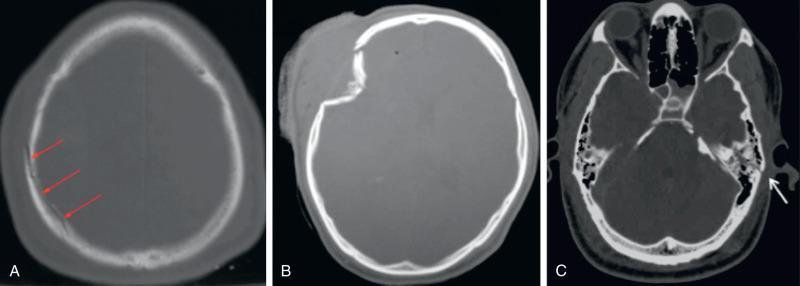
Traumatic intracranial hemorrhages occur when a blood vessel within the skull is damaged. Hemorrhage can occur at the epidural, subdural, arachnoid spaces or within the brain matter. A subdural hematoma is the most common hemorrhage after traumatic head injury. It is a brain bleed that has created its own space between the dura mater and the arachnoid mater. It is typically the result of a blow to the head that causes the brain to thrust back and forth within the skull; most often tearing a superior cerebral vein as it enters the superior sagittal sinus. It also can be caused by the rupture of a subdural artery. This type of hemorrhage follows the contour of the brain in a concave shape ( Fig. 122.3A ). An epidural hematoma is also typically the result of a blow to the head. However, this type of bleed is different from a subdural hematoma in that it is most commonly arterial in origin and occurs when blood from a torn branch of the middle meningeal artery collects between the skull and the dura mater. This can cause compression of brain tissue, requiring surgical evacuation. Epidural hematomas are usually associated with a lucid interval; which is a temporary improvement of the patient's condition after a TBI. The patient lapses into unconsciousness after recovery from the initial concussive force when the continued bleeding causes expansion of the hematoma past the brain's ability to compensate. The hemorrhage expands along the epidural space, but it does not cross the suture lines, forming a concave shape (see Fig. 122.3B ). Cerebral contusions are another type of brain bleed that can occur after head trauma, and is a bruise of the brain tissue. It is associated with multiple diffuse or localized microhemorrhages from ruptured veins or arteries. It commonly occurs in coup injuries where the brain is bruised directly under the area of impact, and/or contrecoup injuries in which the brain is injured on the side opposite to the impact. The brain is easily bruised near sharp ridges of the inside of the skull under the frontal and temporal lobes, making the frontal and temporal lobes the most common contused areas of the brain (see Fig. 122.3D ). A subarachnoid hemorrhage is an arterial bleed into the subarachnoid space and may occur as a result of a head injury, the most common, or spontaneously, from a ruptured cerebral aneurysm or an arteriovenous malformation (see Fig. 122.3C ).
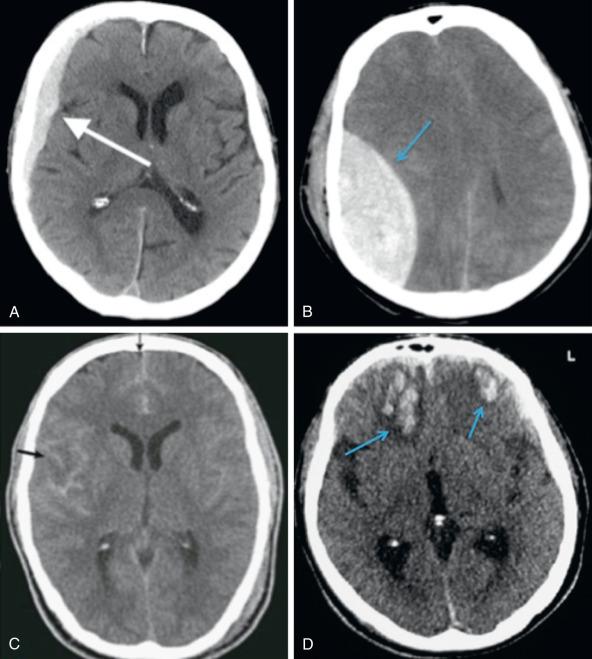
A concussion is a temporary loss of brain function after a head trauma. It is also known as minor head trauma or mild traumatic brain injury. It is the most common type of TBI. The patient may or may not experience a temporary loss of consciousness, and intracranial hemorrhage or skull fracture may or may not be present. Therefore concussion is usually a diagnosis of exclusion and is considered a complex neurobehavioral syndrome with a multi-faceted clinical dilemma. A concussion is caused by a rapid acceleration or deceleration of an individual's brain within their skull, caused by either a direct or indirect blow to their head. This can occur in either a linear or rotational fashion; which then causes intracranial imbalances and metabolic changes to occur. According to the Centers for Disease Control and Prevention, the number of emergency department, sports recreation-related traumatic brain injury (SRR-TBI) treatments increased between 2001 and 2012. During that time, there were approximately 3.42 million emergency room visits for children between the ages of 0 and 19 for the treatment of SRR-TBI. Activities associated with the SRR-TBI varied by age and gender. There are many factors believed to play a role in how an individual is able to diffuse the impact sustained from a possible concussive force. Musculoskeletal strength as well as the musculoskeletal weakness of the individual—specifically the core and neck musculature, the levels of CSF of the individual, and the self-awareness of either a direct or indirect impact—are all believed to be possible factors in one's ability to defuse a possible concussive hit. For instance, the role of the CSF inside the cranium may play a role in decreasing concussions. If the forces exerted are not great enough to exceed the threshold needed to force the brain to impact the interior of the skull, an injury may not occur. A linear acceleration/deceleration action can occur in multiple different ways. For instance, a top-of-the-head type impact or anterior-to-posterior type injury can cause a coup or a coup-countrecoup-type mechanism of injury. A coup-countrecoup type of injury occurs on the side of the impact, as well as on the opposite side due to the rebounding of the brain inside the cranium, whereas a coup injury occurs only at the site of impact. Rotational acceleration impacts are thought to be more likely the cause of loss of consciousness in concussions rather than linear/translational acceleration types of impacts. This is likely due to the location of the injury. It is believed that the rotational acceleration impact causes shearing and tensile strains of the cerebrum about the brainstem. Since one of the functions of the brainstem is consciousness, one could hypothesize that if the brain stem were affected, consciousness could be as well.
The mechanical etiology of concussions and brain injury, as well as their neurologic consequence, are complex and continue to be researched. Concussions represent a clinical dilemma for sports medicine professionals. Understanding the anatomy, biomechanics, and varied symptoms is essential in furthering the understanding and advancement in the course of their treatment.
The adult spine is composed of 33 vertebrae, or bony blocks, which protect the spinal cord and nerve roots, and support the cranium. The typical arrangement is 7 cervical, 12 thoracic, 5 lumbar, and 3 to 5 fused sacral and coccygeal vertebrae ( Fig. 122.4A ), although numerous variations in normal anatomy exist in up to 10% of the population. Each vertebra from the second cervical (C2) to the first sacral (S1) is connected anteriorly by an intervertebral disc, and posteriorly by paired diarthrodial (facet) joints in addition to supporting ligamentous structures (see Fig. 122.4B ). There is variation in size and alignment of the facet joints when moving from cranial to caudal segments, with size increasing more distally in the thoracolumbar and lumbar segments, and the facet joints being more coronally oriented in the thoracic spine, and more sagittally oriented in the lumbar spine. The three-column concept of spinal stability as described by Denis remains important in describing spinal injuries of all mechanisms including those from athletic injuries. According to Denis, the anterior column is composed of the anterior two-thirds of the vertebral body, disk, and anterior longitudinal ligament; the middle column is composed of the posterior third of the vertebral body, disk, and posterior longitudinal ligament; and the posterior column is composed of the facet joints, facet capsules, ligamentum flavum, and interspinous and supraspinous ligaments. When at least two of the three columns are disrupted, the result is a potentially unstable spine that may require surgical stabilization.
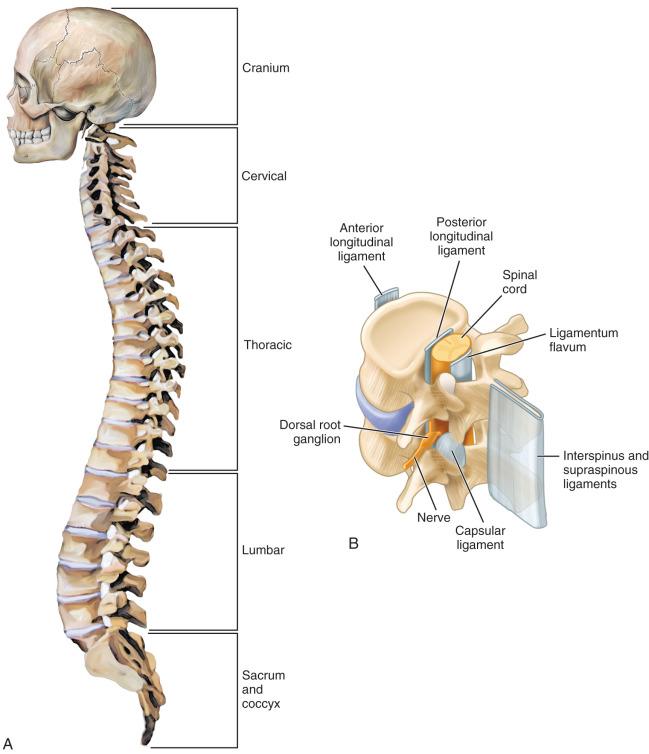
The cervical and lumbar spines are lordotic, while the thoracic spine and sacrum are naturally kyphotic (see Fig. 122.4A ). Normal thoracic kyphosis is 10 to 40 degrees, and normal lumbar lordosis is 40 to 60 degrees, noting that an approximate difference of 30 degrees between thoracic kyphosis and lumbar lordosis will place most patients into good sagittal plane balance.
The cervical spine is composed of seven vertebrae, including C1 (the atlas), C2 (the axis), and five subaxial (below C2) vertebrae, which share similar characteristics. The atlas has no vertebral body but consists of a bony ring containing lateral masses that lie between the superior and inferior articular processes, which articulate with the occiput and C2 (axis), respectively. Synovial condylar joints are present at the occiput–C1 articulation, whereas the C2–C3 vertebrae and all subaxial vertebrae are connected by an intervertebral disc anteriorly, and by paired diarthrodial (facet) joints posteriorly, along with supporting ligaments. The intervertebral disc primarily resists axial loads and acts as the “shock absorber ” of the spine, while the posterior elements, including the facet joints, provide rotational stability and resist extension forces. The second cervical vertebra contain a peg-shaped odontoid process (dens) that articulates with the anterior C1 ring and accounts for approximately 50% of cervical rotation, while the occiput–C1 junction accounts for approximately 50% of flexion and extension. There is a complex interplay of ligaments at the craniocervical and atlantoaxial junctions, which allow for a physiologic range of motion (ROM) of the cervical spine. The anterior longitudinal ligament runs anterior to the vertebral bodies; the posterior longitudinal ligament is contiguous with the tectorial membrane; and the apical and transverse ligaments stabilize the atlantodental and atlantoaxial motion segments, respectively ( Fig. 122.5A ). One unique feature of the cervical spine is the presence of the uncovertebral joints of Luschka, allowing a bony articulation at the lateral edge of each disc space. The paired facet joints at the posterolateral aspect of each motion segment contain synovial fluid between the articular cartilage segments contained by a ligamentous capsule, and provide stability to torsional and bending loads. The vertebral artery arises from the subclavian artery and enters the spine at the transverse foramen at C6 in most cases, providing blood supply to the posterior cerebral circulation via the basilar artery. It can be vulnerable to injury in cervical spine trauma due to its close confines as it passes proximally from the C6 transverse foramen to the C1 foramen (V2 segment) and then passes along the posterior superior C1 ring (V3 segment) until it reaches approximately 1 cm from the midline and then enters the dura (V4 segment). The cervical spine attaches to the thoracic spine and rib cage at the cervicothoracic junction, where the seventh cervical lateral mass articulates with the superior articular facet of the first thoracic vertebra and first rib. The cervical spine is the segment most prone to catastrophic injury in sports as it lacks the inherent stability of the rib cage at the thoracic levels, and contains the cervical spinal cord that is critical for upper and lower extremity motor and sensory function in addition to bowel and bladder control.
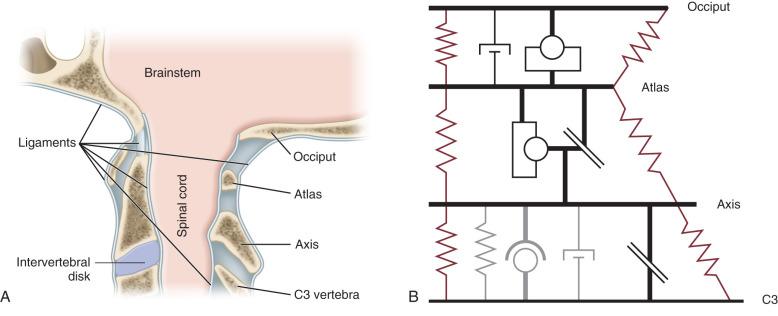
The kyphotic thoracic spine contains smaller vertebral bodies than those in the cervical spine, and has facets that are oriented in a more coronal plane. The transverse processes are longer and contain several articulations with the adjacent rib head. Rather than lateral masses containing the superior and inferior articulating facets, as in the cervical spine, the thoracic and lumbar spine contain a pars region, which is a narrow, lateral extension of the lamina that acts as a bridge between the superior articulating and inferior articulating facets. This area is especially prone to injury at the C2 and L5 levels due to regional anatomic variations, (elongation at C2, and thin medial to lateral dimension at L5). In the lumbar spine, the vertebral bodies are larger in order to support the trunk and greater forces in this region, and the facet joints are more sagittally oriented, which allows for more flexion and extension. As noted previously, anatomic variations are present in approximately 10% of spines, commonly consisting of segmentation anomalies (sacralization of L5, rudimentary rib at L1), spina bifida occulta (absence of a portion or all of the lamina) and pars defects.
The intervertebral disk is a fibrocartilaginous structure that forms the mobile articulation between adjacent vertebrae in the anterior and middle columns from the C2 to S1 levels. In an adult, the disk is avascular and receives its nutrients through diffusion from the cartilaginous endplates. It displays both viscoelastic and time-dependent properties, and contains a soft, inner core (the nucleus pulopsus) and a more rigid, outer ring containing concentric lamellae (annulus fibrosus). The annulus is a ring containing type I collagen arranged in concentric lamellae approximately 65 degrees from the spinal axis, while the nucleus is an amorphous gel of type II collagen and proteoglycans, composed of almost 90% water in a young, healthy person. The outer layers of the annulus fibrosus are innervated by sensory nerve structures, whereas the inner annulus and nucleus lack innervation. This is important in that intervertebral disk herniations can become painful when pathologic or repeated physiologic stresses affect the structural integrity of the annulus. The nucleus pulposus is able to distribute and transfer compressive loads through its attachments to the surrounding annulus fibrosus, and loss of this normal physiologic process leads to increased load transfer to the facet joints and posterior structures. Disc degeneration occurs as water content is lost and annular fissuring occurs; this is most common clinically at the L4–L5 and L5–S1 levels as well as the lower cervical spine.
Become a Clinical Tree membership for Full access and enjoy Unlimited articles
If you are a member. Log in here